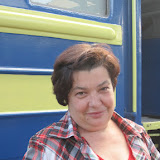As energy demands increase globally, so do the pressure and
support to expand unsustainable energy sources and extraction. The resulting
environmental and public health impacts, most notably the catastrophe at Fukushima , underscor e the global urgency of developing alternative,
sustainable energy resources.
This fall, CSE brought
five US experts to Ukraine to share with NGO and local government leaders the US
experience with environmental and health
impacts of hydraulic fracturing and positive examples of its alternatives. Our three-day conference, co-or ganized by CSE and Ukraine ’s
EcoClub Rivne, included Kari Matsko, a software engineer from Ohio who has struggled with severe health
issues as a result of living only 2,500 feet from a fracked gas well. Unlike
other members of her community, she didn’t sign a non-disclosure agreement. Kari speaks up for
the thousands of those who cannot by sharing the truth about health impacts of
extracting gas by injecting highly pressurized water mixed with harmful
chemicals to fracture shale rocks. Our
Ukrainian counterparts were able to learn about these truths, which helped
shape their own campaigns in their struggle to fight against fracking in Ukraine . Thanks
to Kari’s leadership and founding of the People’s Oil and Gas Collective, in
2010 the state of Ohio
improved its oil and gas laws, which had not been changed since 1965!
We were fortunate to have Dr. Larysa Dyrszka join our delegation
to Ukraine ,
as she provided the medical truths of fracking. A pediatrician and member of Physicians, Scientists, and Engineers for Health Energy, she shared the results of
on-the-ground public health assessments and how here in the US , we have a
long upward battle against big industry claims that fracking is “safe”.
From a local government perspective, Sanders gave examples
of how citizens and local government can work together for sustainability and
energy efficiency, drawing on her experience leading energy and climate
planning initiatives in El Cerrito, California. Professor John Perkins,
who recently joined the CSE staff as our Energy Consultant, provided a larger
context for addressing energy issues
in both countries, reminding us that we have to look at energy systems as a
whole, with efficiency and renewable technology being most impor tant.
This particular configuration of representation of
non-profit, medical, academic, and government sectors provided a holistic
approach to addressing energy issues in both the US and Ukraine. Just as one energy source cannot be examined
without connecting it to the larger energy system, each sector of the community
needs to be seen as part of a connected system.
Participation in this exchange brought to light the crucial importance of personal exchanges. Ukraine , and
the rest of Europe , looks to the US as the only
example of a developed fracking industry and hears little of the opposition. Unfor tunately, because of its desire to become energy
independent from Russia ,
the Ukrainian government closed a deal with major
oil and gas companies to pursue fracking contracts.
Along with the disappointing decision to pursue fracking in
Ukraine, the fight for democracy and justice can be seen today, in Ukraine’s
bloody crackdown of Euromaidan. Public health systems are very weak, and
without that, environmental and health impacts will not be tracked. This makes
continuing the work of our delegation even mor e
urgent and we plan to continue our efforts in the region.











